3D-VAR Data Assimilation of SEVIRI Radiances for the Prediction of Solar Irradiance in Italy Using WRF Solar Mesoscale Model—Preliminary Results
Abstract
1. Introduction
2. Materials and Methods
2.1. Numerical Weather Prediction Model and the WRF-IMAA-Solar Setup
2.2. D-VAR Data Assimilation of SEVIRI Radiance
2.3. Observational Data Sets
- The MSG Meteorological Product Extraction Facility (MPEF) Cloud Mask (CLM) product describes the scene type (either ’clear’ or ’cloudy’) on a pixel level. The MPEF-CLM algorithm uses a set of threshold tests on reflectance, brightness temperature and brightness temperature differences of channel properly chosen in order to classify each pixel as clear sky over water, clear sky over land, cloud, or not processed (off Earth disc). Data are available in network Common Data Form (netCDF) format and have a frequency of 15 min [51,52,53].
- The Ocean and Sea Ice Satellite Application Facility (OSI SAF) hourly shortwave Surface Solar Irradiance (SSI) (W/m2) gives an estimate of the solar irradiance reaching the Earth’s surface. It is derived from the 0.6 µm visible channel of SEVIRI from MSG platform and it is produced by remapping over a 0.05° regular grid. The data are available in GRIdded Binary 2 (GRIB2) format with an hourly frequency [54,55].
2.4. The Two Simulated Periods
2.5. The Statistical Methodology
- Proportion Correct (PC) = (A + D)/(A + B + C + D);
- False Alarm Rate (FAR) = B/(A + B);
- Miss Rate (MR) = C/(A + C);
- BIAS = (A + B)/(A + C);
3. Results and Discussion
- ASSIM1: WRFDA uses the default B matrix.
- ASSIM2: WRFDA uses a domain specific B matrix that considers the climatological aspects of the area.
4. Conclusions
Author Contributions
Funding
Conflicts of Interest
References
- GSE (Gestore dei Servizi Energetici) Statistical Report (Italian Only). Available online: https://www.gse.it/documenti_site/Documenti%20GSE/Rapporti%20statistici/Solare%20Fotovoltaico%20-%20Rapporto%20Statistico%202018.pdf (accessed on 27 January 2020).
- Perez, R.; Lorenz, E.; Pelland, S.; Beauharnois, M.; Knowe, G.V.; Hemker, K.; Heinemann, D., Jr.; Remund, J.; Müller, S.C.; Traunmüller, W.; et al. Comparison of numerical weather prediction solar irradiance forecasts in the US, Canada and Europe. Sol. Energy 2013, 94, 305–326. [Google Scholar] [CrossRef]
- Remund, J.; Perez, R.; Lorenz, E. Comparison of solar radiation forecasts for the USA. In Proceedings of the 23rd European Photovoltaic Solar Energy Conference, Valencia, Spain, 1–5 September 2008. [Google Scholar]
- Chow, C.W.; Urquhart, B.; Kleissl, J.; Lave, M.; Dominguez, A.; Shields, J.; Washom, B. Intra-hour forecasting with a total sky imager at the UC San Diego solar energy testbed. Sol. Energy 2011. [Google Scholar] [CrossRef]
- Pedro, H.T.; Coimbra, C.F. Assessment of forecasting techniques for solar power production with no exogenous inputs. Sol. Energy 2012, 86, 2017–2028. [Google Scholar] [CrossRef]
- Lorenz, E.; Hammer, A.; Heinemann, D. Short term forecasting of solar radiation based on satellite data. In Proceedings of the EUROSUN2004 (ISES Europe Solar Congress), Freiburg, Germany, 20–23 June 2004. [Google Scholar]
- Gallucci, D.; Romano, F.; Cersosimo, A.; Cimini, D.; Di Paola, F.; Gentile, S.; Geraldi, E.; Larosa, S.; Nilo, S.T.; Ricciardelli, E.; et al. Nowcasting Surface Solar Irradiance with AMESIS via Motion Vector Fields of MSG-SEVIRI Data. Remote Sens. 2018, 10, 845. [Google Scholar] [CrossRef]
- Romano, F.; Cimini, D.; Cersosimo, A.; Di Paola, F.; Gallucci, D.; Gentile, S.; Geraldi, E.; Larosa, S.; Nilo, S.T.; Ricciardelli, E.; et al. Improvement in Surface Solar Irradiance Estimation Using HRV/MSG Data. Remote Sens. 2018, 10, 1288. [Google Scholar] [CrossRef]
- Perez, R.; Kivalov, S.; Schlemmer, J.; Hemker, K.; Renné, D.; Hoff, T.E. Validation of Short and Medium Term Operational Solar Radiation Forecasts in the US. Sol. Energy 2010, 84, 2161–2172. [Google Scholar] [CrossRef]
- Diagne, M.; David, M.; Lauret, L.; Boland, J.; Schmutz, N. Review of solar irradiance forecasting methods and a proposition for small-scale insular grids. Renew. Sustain. Energy Rev. 2013, 27, 65–76. [Google Scholar] [CrossRef]
- Nonnenmacher, L.; Coimbra, C.F. Streamline-based method for intra-day solar forecasting through remote sensing. Sol. Energy 2014, 108, 447–459. [Google Scholar] [CrossRef]
- Inman, R.H.; Pedro, H.T.C.; Coimbra, C.F.M. Solar forecasting methods for renewable energy integration. Prog. Energy Combust. Sci. 2013, 39, 535–576. [Google Scholar] [CrossRef]
- Lara-Fanego, V.; Ruiz-Arias, J.A.; Pozo-Vázquez, D.; Santos-Alamillos, F.J.; Tovar-Pescador, J. Evaluation of the WRF model solar irradiance forecasts in Andalusia (southern Spain). Sol. Energy 2012, 86, 2200–2217. [Google Scholar] [CrossRef]
- Perez, R.; Hoff, T. Solar Anywhere Forecasting, in: Solar Energy Forecasting and Resource Assessment; Kleissl, J., Ed.; Elsevier: Amsterdam, The Netherlands, 2013. [Google Scholar] [CrossRef]
- Lorenz, E.; Remund, J.; Müller, S.C.; Traunmüller, W.; Steinmaurer, G.; Pozo, D.; Ruiz-Arias, J.A.; Lara Fanego, V.; Ramirez, L.; Romeo, M.G.; et al. Benchmarking of Different Approaches to Forecast Solar Irradiance. In Proceedings of the 24th European Photovoltaic Solar Energy Conference, Hamburg, Germany, 21–25 September 2009; pp. 4199–4208. [Google Scholar] [CrossRef]
- Lo Feudo, T.; Avolio, E.; Gulli, D.; Federico, S.; Calidonna, C.R.; Sempreviva, A.M. Comparison of hourly solar radiation from a ground-based station remote sensing and weather forecast models at a coastal site of South Italy (Lamezia Terme). Energy Procedia 2015, 76, 148–155. [Google Scholar] [CrossRef]
- Gómez, I.; Caselles, V.; Estrela, M.J. Seasonal Characterization of Solar Radiation Estimates Obtained from a MSG-SEVIRI-Derived Dataset and a RAMS-Based Operational Forecasting System over the Western Mediterranean Coast. Remote Sens. 2016, 8, 46. [Google Scholar] [CrossRef]
- Gómez, I.; Caselles, V.; Estrela, M.J.; Miró, J.J. Comparative assessment of RAMS and WRF short-term forecasts over Eastern Iberian Peninsula using various in-situ observations, remote sensing products and uncoupled land surface model datasets. Atmos. Res. 2018, 213, 476–491. [Google Scholar] [CrossRef]
- Haupt, S.E.; Kosovic, B.; Jensen, T.L.; Lee, J.; Jimenez Munoz, P.; Lazo, J.K.; Hinkleman, L. The Sun4Cast Solar Power Forecasting System: The Result of the Public-Private-Academic Partnership to Advance Solar Power Forecasting (No. NCAR/TN-526+STR). Natl. Center Atmos. Res. (NCAR) Boulder (CO) Res. Appl. Lab. Weather Syst. Assess. Program (US) 2016. [Google Scholar] [CrossRef]
- Haupt, S.E.; Kosović, B.; Jensen, T.; Lazo, J.K.; Lee, J.A.; Jiménez, P.A.; Cowie, J.; Wiener, G.; McCandless, T.C.; Rogers, M.; et al. Building the Sun4Cast system: Improvements in solar power forecasting. Bull. Am. Meteorol. Soc. 2017, 99, 121–136. [Google Scholar] [CrossRef]
- Kurzrock, F.; Cros, S.; Ming, F.C.; Otkin, J.A.; Hutt, A.; Linguet, L.; Lajoie, G.; Potthast, R. A Review of the Use of Geostationary Satellite Observations in Regional-scale Models for Short-term Cloud Forecasting. Meteorol. Z. 2018, 27, 277–298. [Google Scholar] [CrossRef]
- Cros, S.; Sébastien, N.; Liandrat, O.; Schmutz, N. Cloud pattern prediction from geostationary meteorological satellite images for solar energy forecasting. In Proceedings of the SPIE. Remote Sensing of Clouds and the Atmosphere XIX; and Optics in Atmospheric Propagation and Adaptive Systems XVII, Amsterdam, The Netherlands, 22 and 24– 25 September 2014; p. 924202. [Google Scholar] [CrossRef]
- Lorenz, E.; Kühnert, J.; Heinemann, D. Overview of irradiance and Photovoltaic Power Prediction. In Weather Matters for Energy; Troccoli, A., Dubus, L., Haupt, S.E., Eds.; Springer: New York, NY, USA, 2014; pp. 429–454. [Google Scholar]
- Tanvir, I.; Srivastava, P.K.; Kumar, D.; Petropoulos, G.P.; Dai, Q.; Zhuo, L. Satellite radiance assimilation using a 3DVAR assimilation system for hurricane Sandy forecasts. Nat. Hazards 2016, 82, 845–855. [Google Scholar] [CrossRef][Green Version]
- Yang, C.; Liu, Z.; Bresch, J.; Rizvi, S.R.H.; Huang, X.-Y.; Min, J. AMSR2 all-sky radiance assimilation and its impact on the analysis and forecast of Hurricane Sandy with a limited-area data assimilation system. Tellus 2016, 68A, 30917. [Google Scholar] [CrossRef]
- Xie, Y.; Xing, J.; Shi, J.; Dou, Y.; Lei, Y. Impacts of radiance data assimilation on the Beijing 7.21 heavy rainfall. Atmos. Res. 2016, 169, 318–330. [Google Scholar] [CrossRef]
- Xu, D.; Min, J.; Shen, F.; Ban, J.; Chen, P. Assimilation of MWHS radiance data from the FY-3B satellite with the WRF Hybrid-3DVAR system for the forecasting of binary typhoons. J. Adv. Model. Earth Syst. 2016, 8, 1014–1028. [Google Scholar] [CrossRef]
- Gustafsson, N.; Janji´c, T.; Schraff, C.; Leuenberger, D.; Weissmann, M.; Reich, H.; Brousseau, P.; Montmerle, T.; Wattrelot, E.; Buˇcánek, A.; et al. Survey of data assimilation methods for convective-scale numerical weather prediction at operational centres. Quart. J. R. Meteor. 2018. [Google Scholar] [CrossRef]
- Stengel, M.; Undén, P.; Lindskog, M.; Dahlgren, P.; Gustafsson, N.; Bennartz, R. Assimilation of SEVIRI infrared radiances with HIRLAM 4DVar. Q. J. R. Meteorol. Soc. 2009, 135 Pt B, 2100–2109. [Google Scholar] [CrossRef]
- Stengel, M.; Lindskog, M.; Undén, P.; Gustafsson, N.; Bennartz, R. An extended observation operator in HIRLAM 4D-VAR for the assimilation of cloud-affected satellite radiances. Q. J. R. Meteorol. Soc. 2010, 136, 1064–1074. [Google Scholar] [CrossRef]
- Stengel, M.; Lindskog, M.; Undén, P.; Gustafsson, N. The impact of cloud-affected IR radiances on forecast accuracy of a limited-area NWP model. Q. J. R. Meteorol. Soc. 2013, 139, 2081–2096. [Google Scholar] [CrossRef]
- Yang, C.; Liuz, Z.; Gao, F.; Child, P.P.; Min, J. Impact of assimilation goes imager clear-sky radiance with a rapid refresh assimilation system for convection-permitting forecast over Mexico. J. Geophys. Res. Atmos. 2017, 122, 5472–5490. [Google Scholar] [CrossRef]
- Skamarock, W.C.; Klemp, J.B.; Dudhia, J.; Gill, D.O.; Barker, D.M.; Wang, W.; Powers, J.G. A description of the Advanced Research WRF Version 3; NCAR Technical Note, NCAR/TN-475+STR. 2008. Available online: http://opensky.ucar.edu/islandora/object/technotes:500 (accessed on 25 May 2018).
- Jimenez, P.A.; Hacker, J.P.; Dudhia, J.; Haupt, S.E.; Jose, R.A.; Gueymard, C.A.; Thompson, G.; Eidhammer, T.; Deng, A. WRF-Solar: Description and Clear-Sky Assessment of an Augmented NWP Model for Solar Power Prediction. Bull. Am. Met. Soc. 2016, 97, 1249–1264. [Google Scholar] [CrossRef]
- Thompson, G.; Eidhammer, T. A Study of Aerosol Impacts on Clouds and Precipitation Development in a Large Winter Cyclone. J. Atmos. Sci. 2014, 71, 3636–3658. [Google Scholar] [CrossRef]
- Hong, S.Y.; Noh, Y.; Dudhia, J. A New Vertical Diffusion Package with an Explicit Treatment of Entrainment Processes. Mon. Weather Rev. 2006, 134, 2318–2341. [Google Scholar] [CrossRef]
- Iacono, M.J.; Delamere, J.S.; Mlawer, E.J.; Shephard, M.W.; Clough, S.A.; Collins, W.D. Radiative forcing by long-lived greenhouse gases: Calculations with the AER radiative transfer models. J. Geophys. Res. Atmos. 2008, 113. [Google Scholar] [CrossRef]
- Kain, J.S. The Kain–Fritsch Convective Parameterization: An Update. J. Appl. Meteorol. 2004, 43, 170–181. [Google Scholar] [CrossRef]
- Singh, R.; Ojha, S.P.; Kishtawal, C.M.; Pal, P.K.; Kumar, A.S.K. Impact of the assimilation of INSAT-3D radiances on short-range weather forecasts. Quart. J. R. Meteor. Soc. 2016, 142, 120–131. [Google Scholar] [CrossRef]
- Schmid, J. The SEVIRI Instrument. In Proceedings of the 2000 EUMETSAT Meteorological Satellite. Data User’s Conference, Bologna, Italy, 29 May–2 June 2000; Darmstadt, Germany, EUMETSAT ed (2000). pp. 13–32. [Google Scholar]
- Barker, D.M.; Huang, W.; Guo, Y.-R.; Bourgeois, A.; Xiao, Q. A Three-Dimensional Variational (3DVAR) Data Assimilation System For Use With MM5: Implementation and Initial Results. Mon. Weather Rev. 2004, 132, 897–914. [Google Scholar] [CrossRef]
- Barker, D.; Huang, X.-Y.; Liu, Z.; Auligné, T.; Zhang, X.; Rugg, S.; Ajjaji, R.; Bourgeois, A.; Bray, J.; Chen, Y.; et al. The Weather Research and Forecasting Model’s Community Variational/Ensemble Data Assimilation System: WRFDA. Bull. Am. Meteor Soc. 2012, 93, 831–843. [Google Scholar] [CrossRef]
- Han, Y.; van Delst, P.; Liu, Q.; Weng, F.; Yan, B.; Treadon, R.; Derber, J. Community Radiative Transfer Model (CRTM): Version 1; NOAA Technical Report; NOAA: Washington, DC, USA, 2006; 122p.
- Maiello, I.; Gentile, S.; Ferretti, R.; Baldini, L.; Nicoletta, R.; Picciotti, E.; Alberoni, P.P.; Marzano, F.S. Impact of multiple radar reflectivity data assimilation on the numerical simulation of a flash flood event during the HyMeX campaign. Hydrol. Earth Syst. Sci. 2017, 21, 5459–5476. [Google Scholar] [CrossRef]
- Parrish, D.F.; Derber, J.C. The national meteorological center’s spectral statistical-interpolation analysis system. Mon. Weather Rev. 1992, 120, 1747–1763. [Google Scholar] [CrossRef]
- Steinacker, R.; Haberli, C.; Pottschacher, W. A transparent method for the analysis quality evaluation of irregularly distributed noisy observational data. J. Appl. Meteorol. 2000, 12, 2303–2316. [Google Scholar] [CrossRef]
- Lussana, C.; Uboldi, F.; Salvati, M.R. A spatial consistency test for surface observations from mesoscale meteorological networks. Q. J. R. Meteorol. Soc. 2010, 136, 1075–1088. [Google Scholar] [CrossRef]
- Guide to Meteorological Instruments and Methods of Observation; WMO-No. 8; WMO: Geneva, Switzerland, 2018.
- Reda, I. Method to Calculate Uncertainties in Measuring Shortwave Solar Irradiance Using Thermopile and Semiconductor Solar Radiometers; NREL/TP-3B10-52194; National Renewable Energy Lab.(NREL): Golden, CO, USA, 2011.
- Wilcox, S.M.; Myers, D.R. Evaluation of Radiometers in Full-Time Use at the National Renewable Energy Laboratory Solar Radiation Research Laboratory; NREL/TP-550-44627; National Renewable Energy Lab.(NREL): Golden, CO, USA, 2008.
- MTG-FCI: ATBD for Cloud Mask and Cloud Analysis Product. Doc.No. EUM/MTG/DOC/10/0542, Issue: v3, Date: 17 January 2013 WBS: MTG-834200. Available online: http://www.eumetsat.int (accessed on 27 January 2020).
- MSG Meteorological Products Extraction Facility Algorithm Specification Document. Doc.No., EUM/MSG/SPE/022, Issue: v7B e-signed, Date: 23 October 2015. Available online: http://www.eumetsat.int (accessed on 27 January 2020).
- Lutz, H.J. Cloud processing for Meteosat Second Generation. EUMETSAT Tech. Department Tech. Memo. 1999, 4, 26. Available online: https://www.eumetsat.int/website/wcm/idc/idcplg?IdcService=GET_FILE&dDocName=PDF_TM04_MSG-CLOUD-PROCESSING&RevisionSelectionMethod=LatestReleased&Rendition=Web (accessed on 27 January 2020).
- EUMETSAT, 2018 (I): SAF/OSI/CDOP3/MF/TEC/MA/182, GEO DLI & SSI PUM, 26 February 2018, “Geostationary Radiative Fluxes Product User Manual”. Available online: http://www.osi-saf.org/lml/doc/osisaf_cdop2_ss1_pum_geo_flx.pdf (accessed on 27 January 2020).
- EUMETSAT, 2018 (II): SAF/OSI/CDOP3/MF/SCI/RP/328, Anne Marsouin, Météo-France/CMS, 6 November 2018, “Radiative fluxes validation report for GOES-16 OSI-305-a OSI-306-a Meteosat-11 OSI-303-a OSI-304-a Meteosat-8 OSI-IO-DLI OSI-IO-SSI”. Available online: http://www.osi-saf.org/lml/doc/osisaf_cdop2_ss1_geo_flx_val_rep.pdf (accessed on 27 January 2020).
- Gallucci, D.; Romano, F.; Cimini, D.; Di Paola, F.; Gentile, S.; Larosa, S.; Nilo, S.T.; Ricciardelli, E.; Ripepi, E.; Viggiano, M.; et al. Improvement of Hourly Surface Solar Irradiance Estimation Using MSG Rapid Scanning Service. Remote Sens. 2019, 11, 66. [Google Scholar] [CrossRef]
- Haiden, T.; Trentmann, J. Verification of cloudiness and radiation forecasts in the greater Alpine region. Meteorol. Z. 2015, 25, 3–15. [Google Scholar] [CrossRef]
- Yang, H.; Kleissl, J. Preprocessing WRF initial conditions for coastal stratocumulus forecasting. Sol. Energy 2016, 133, 180–193. [Google Scholar] [CrossRef]
- Yucel, I.; Shuttleworth, W.J.; Pinker, R.T.; Lu, L.; Sorooshian, S. Impact of Ingesting Satellite-Derived Cloud Cover into the Regional Atmospheric Modeling System. Mon. Weather Rev. 2002, 130, 610–628. [Google Scholar] [CrossRef][Green Version]
- Cintineo, R.; Otkin, J.A.; Xue, M.; Kong, F. Evaluating the Performance of Planetary Boundary Layer and Cloud Microphysical Parameterization Schemes in Convection-Permitting Ensemble Forecasts Using Synthetic GOES-13 Satellite Observations. Mon. Weather Rev. 2014, 142, 163–182. [Google Scholar] [CrossRef]
- Bauer, P.; Auligné, T.; Bell, W.; Geer, A.; Guidard, V.; Heilliette, S.; Kazumori, M.; Kim, M.-J.; Liu, E.H.-C.; McNally, A.P.; et al. Satellite cloud and precipitation assimilation at operational NWP centres. Quart. J. R. Meteor. Soc. 2011, 137, 1934–1951. [Google Scholar] [CrossRef]
- Bauer, P.; Ohring, G.; Kummerow, C.; Auligne, T. Assimilating Satellite Observations of Clouds and Precipitation into NWP Models. Bull. Am. Meteor. Soc. 2011, 92, ES25–ES28. [Google Scholar] [CrossRef]
- Bayler, G.M.; Aune, R.M.; Raymond, W.H. NWP Cloud Initialization Using GOES Sounder Data and Improved Modeling of Nonprecipitating Clouds. Mon. Weather Rev. 2000, 128, 3911–3920. [Google Scholar] [CrossRef]
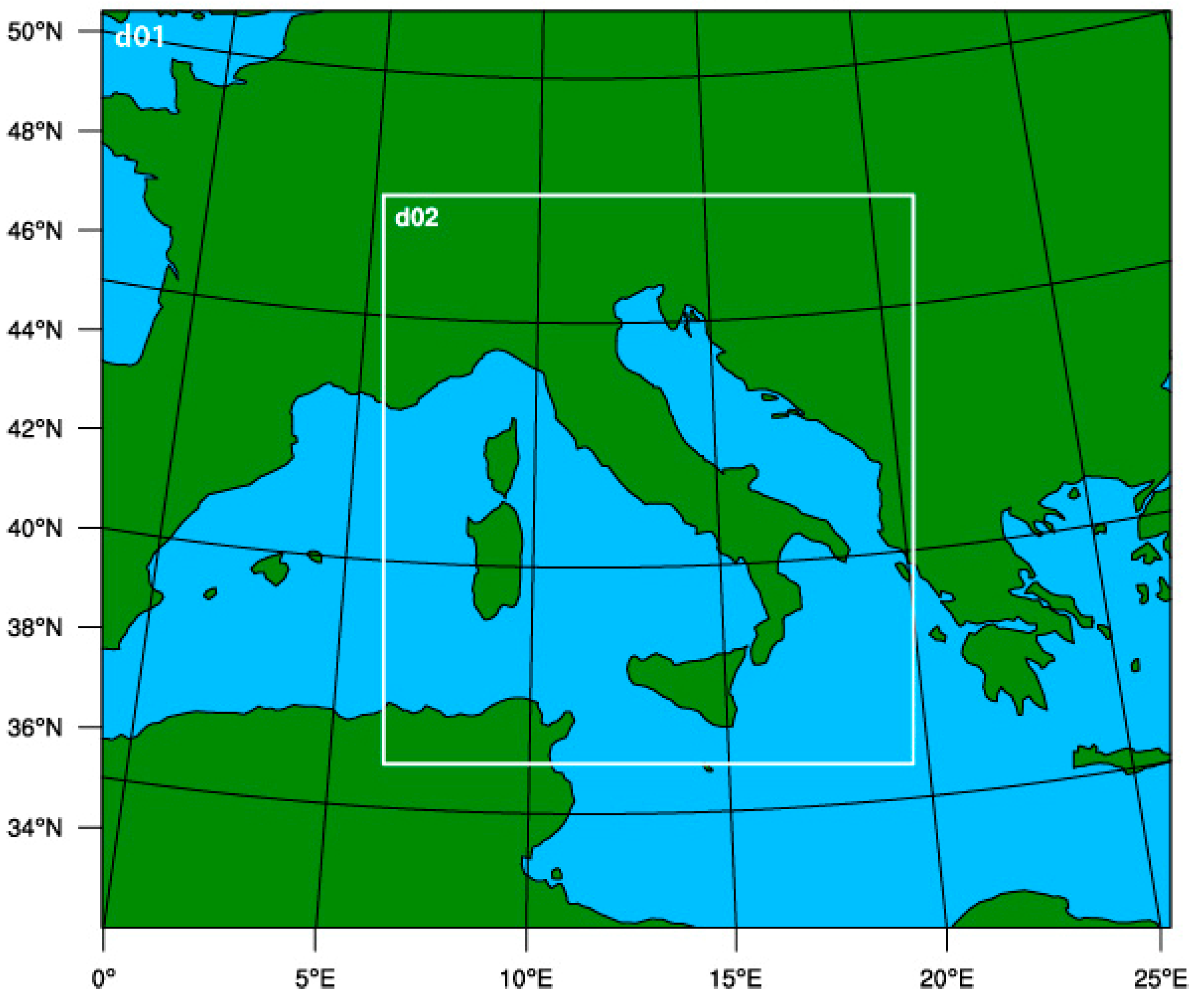
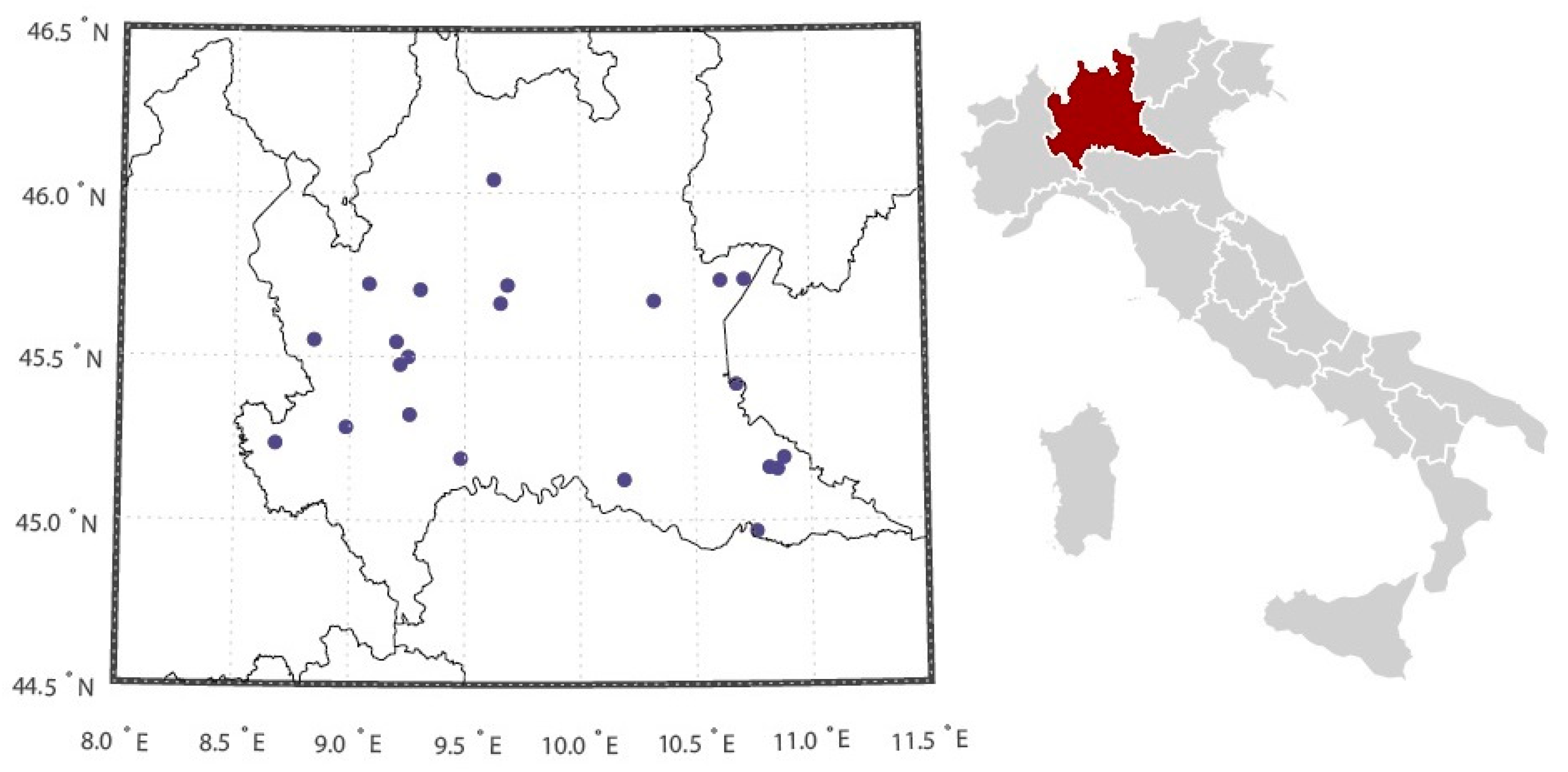

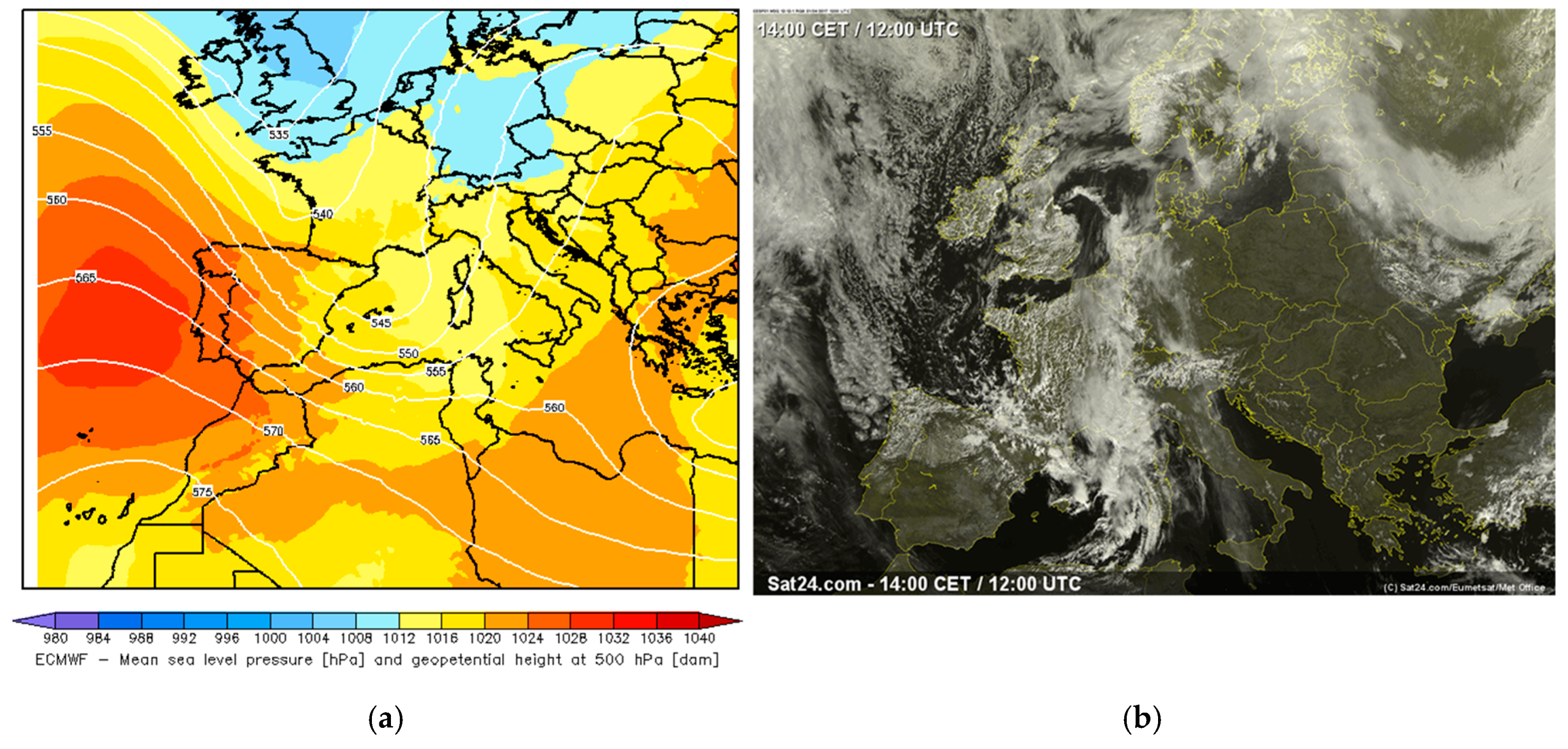
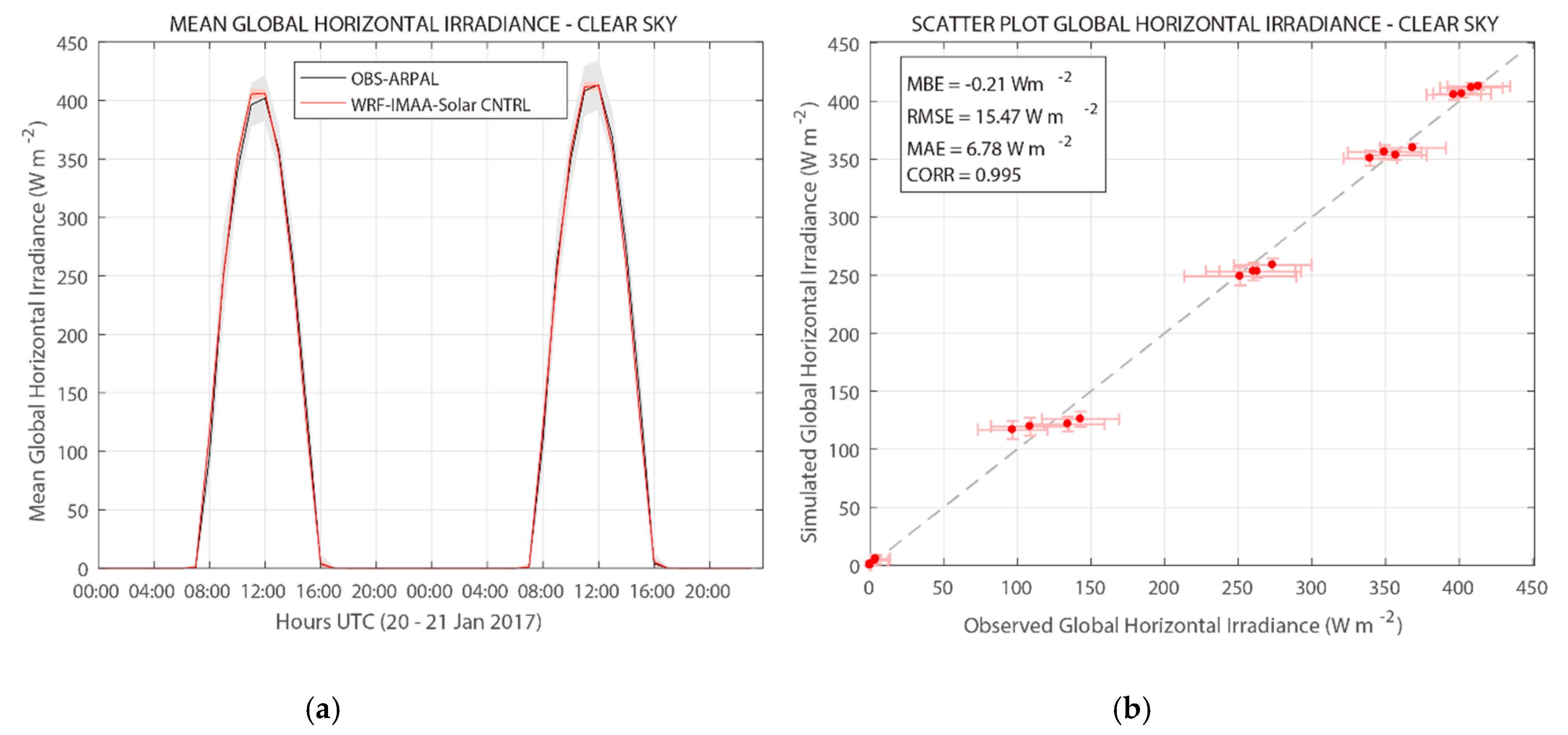

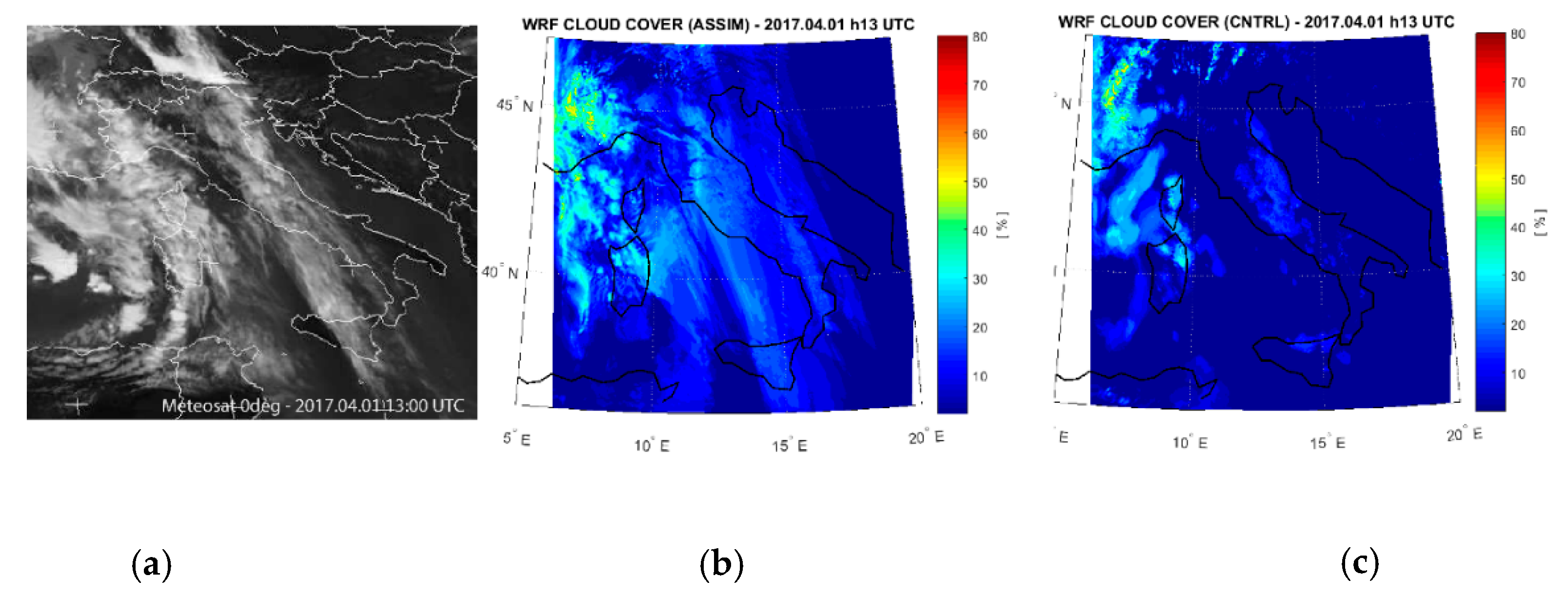


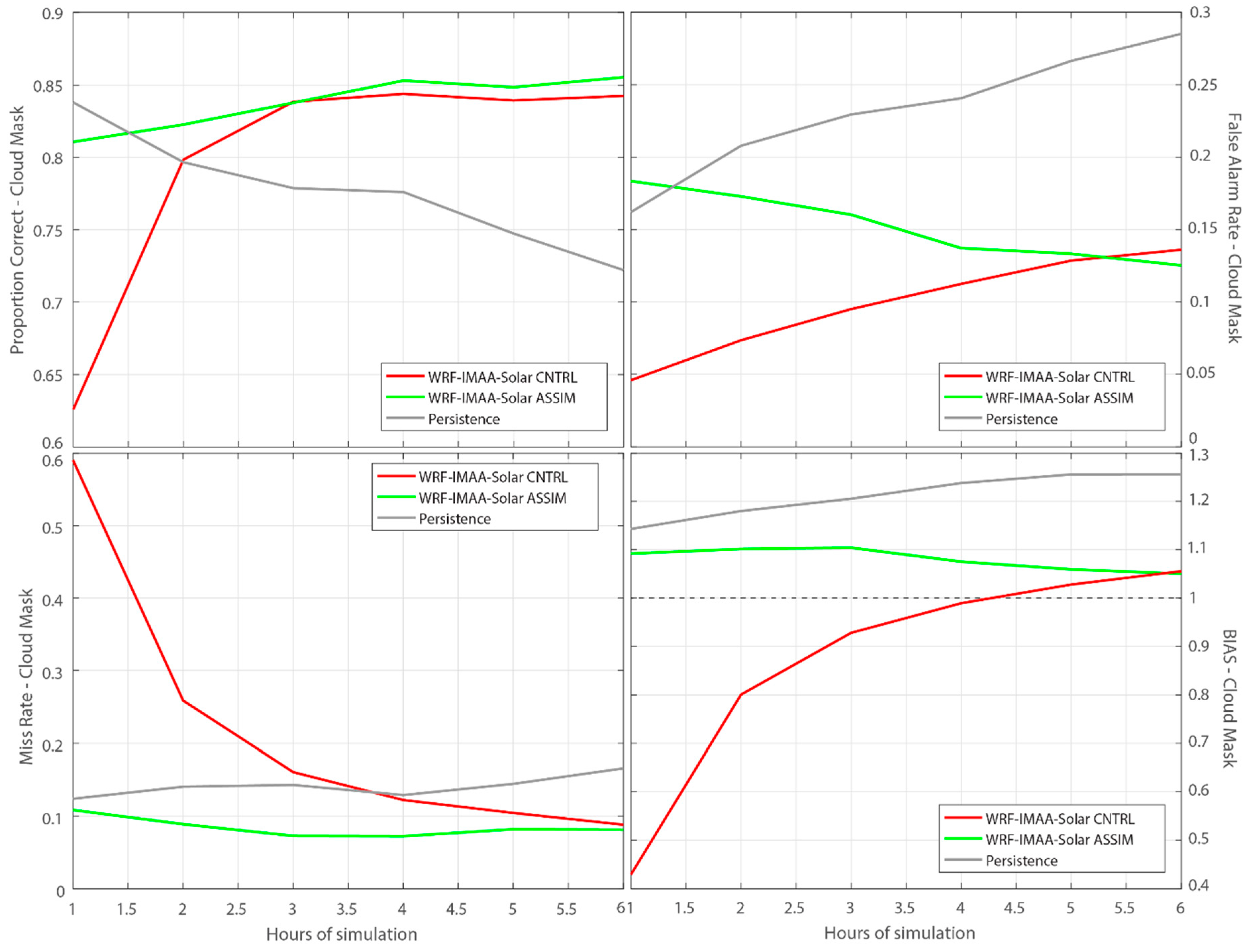
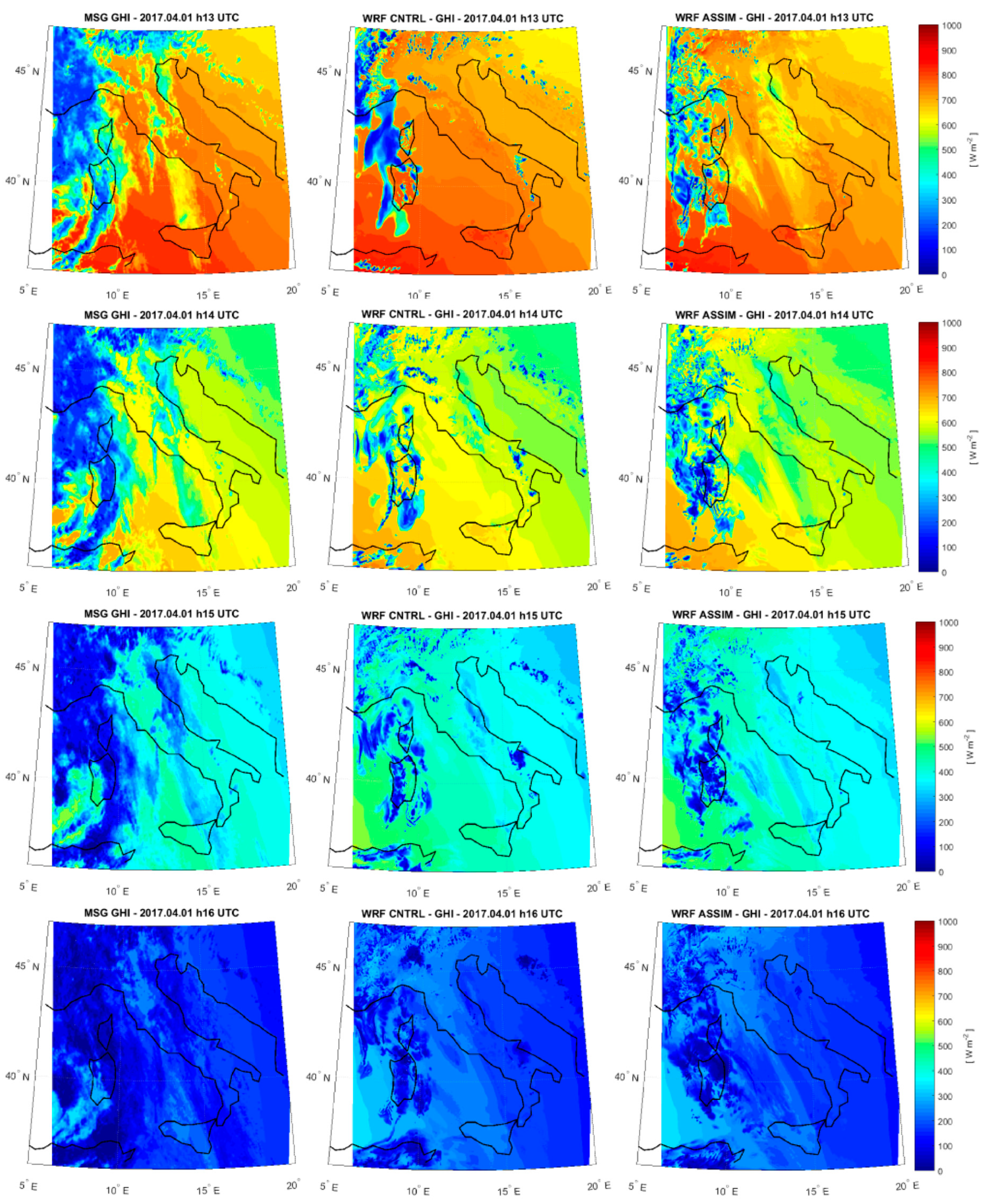

| Station | Longitude | Latitude | Elevation (m) | WRF Elevation (m) |
|---|---|---|---|---|
| Arconate | 8.847 | 45.548 | 120 | 183 |
| Bergamo | 9.659 | 45.660 | 211 | 206 |
| Bergamo – v. Goisis | 9.689 | 45.716 | 290 | 283 |
| Bigarello | 10.887 | 45.188 | 15 | 23 |
| Bione | 10.327 | 45.667 | 911 | 663 |
| Casatenovo | 9.309 | 45.702 | 360 | 312 |
| Castello d’Agogna | 8.683 | 45.233 | 106 | 105 |
| Cinisello Balsamo | 9.205 | 45.543 | 142 | 142 |
| Cornale | 8.914 | 45.040 | 74 | 70 |
| Gargnano | 10.617 | 45.730 | 984 | 929 |
| Gonzaga | 10.767 | 44.964 | 22 | 17 |
| Landriano Cascina Marianna | 9.264 | 45.321 | 88 | 86 |
| Mantova | 10.824 | 45.158 | 25 | 22 |
| Mantova Tridolino | 10.859 | 45.153 | 22 | 22 |
| Mezzoldo Passo S.Marco | 9.629 | 46.038 | 1824 | 1685 |
| Milano | 9.222 | 45.473 | 122 | 124 |
| Milano Lambrate | 9.257 | 45.497 | 120 | 128 |
| Motta Visconti | 8.988 | 45.282 | 100 | 83 |
| Ponti sul Mincio | 10.683 | 45.413 | 113 | 91 |
| Pieve San Giacomo | 10.195 | 45.122 | 39 | 34 |
| San Colombano al Lambro | 9.486 | 45.187 | 80 | 68 |
| Tignale Oldesio | 10.721 | 45.733 | 374 | 229 |
| Vertemate con Minoprio | 9.085 | 45.719 | 310 | 303 |
| Cloud Mask | Observation – yes | Observation – no |
|---|---|---|
| Simulation – yes | A | B |
| Simulation – no | C | D |
| Station | TEST | MBE W/m2 | RMSE W/m2 | MAE W/m2 | CORR |
|---|---|---|---|---|---|
| Arconate | Clear Sky: CNTRL | −2.72 | 5.73 | 3.06 | 0.999 |
| Cloudy sky: CNTRL12 UTC | 90.03 | 171.83 | 90.03 | 0.928 | |
| Cloudy sky: ASSIM 12 UTC | 56.53 | 120.94 | 56.53 | 0.932 | |
| Bergamo | Clear Sky: CNTRL | 1.59 | 4.97 | 2.71 | 0.999 |
| Cloudy sky: CNTRL12 UTC | −18.24 | 38.48 | 19.45 | 0.992 | |
| Cloudy sky: ASSIM 12 UTC | 5.58 | 39.53 | 20.4 | 0.99 | |
| Bergamo – v. Goisis | Clear Sky: CNTRL | 3.12 | 16.74 | 4.52 | 0.995 |
| Cloudy sky: CNTRL12 UTC | 20.65 | 135.59 | 57.56 | 0.86 | |
| Cloudy sky: ASSIM 12 UTC | 42.68 | 154.97 | 58.73 | 0.852 | |
| Bigarello | Clear Sky: CNTRL | −3.79 | 16.74 | 8.3 | 0.993 |
| Cloudy sky: CNTRL12 UTC | 34.45 | 155.78 | 47.17 | 0.846 | |
| Cloudy sky: ASSIM 12 UTC | 51.23 | 135.72 | 65.17 | 0.901 | |
| Bione | Clear Sky: CNTRL | −10.68 | 19.63 | 7.2 | 0.995 |
| Cloudy sky: CNTRL12 UTC | 6.35 | 12.01 | 6.35 | 0.968 | |
| Cloudy sky: ASSIM 12 UTC | 4.41 | 10.22 | 4.61 | 0.979 | |
| Casatenovo | Clear Sky: CNTRL | 2.16 | 10.16 | 5.52 | 0.998 |
| Cloudy sky: CNTRL12 UTC | 26.15 | 98.8 | 53.98 | 0.932 | |
| Cloudy sky: ASSIM 12 UTC | 5.28 | 84.58 | 41.92 | 0.947 | |
| Castello d’Agogna | Clear Sky: CNTRL | 4.11 | 16.73 | 4.12 | 0.994 |
| Cloudy sky: CNTRL12 UTC | 25.67 | 113.98 | 29.98 | 0.885 | |
| Cloudy sky: ASSIM 12 UTC | 38.47 | 136.96 | 39.27 | 0.87 | |
| Cinisello Balsamo | Clear Sky: CNTRL | 4.41 | 19.86 | 7.54 | 0.992 |
| Cloudy sky: CNTRL12 UTC | 32.45 | 108.65 | 36.85 | 0.844 | |
| Cloudy sky: ASSIM 12 UTC | 32.78 | 126.82 | 39.59 | 0.847 | |
| Cornale | Clear Sky: CNTRL | −4.54 | 17.82 | 6.8 | 0.994 |
| Cloudy sky: CNTRL12 UTC | 27.8 | 126.12 | 25.78 | 0.852 | |
| Cloudy sky: ASSIM 12 UTC | 31.3 | 128.52 | 55.49 | 0.853 | |
| Gargnano | Clear Sky: CNTRL | −2.21 | 9.22 | 4.4 | 0.999 |
| Cloudy sky: CNTRL12 UTC | 47.6 | 102.01 | 47.6 | 0.978 | |
| Cloudy sky: ASSIM 12 UTC | 44.44 | 96.67 | 44.44 | 0.977 | |
| Gonzaga | Clear Sky: CNTRL | 4.76 | 18.35 | 7.32 | 0.993 |
| Cloudy sky: CNTRL12 UTC | 26.87 | 121.5 | 45.87 | 0.858 | |
| Cloudy sky: ASSIM 12 UTC | 42.58 | 136.96 | 49.04 | 0.853 | |
| Landriano Cascina Marianna | Clear Sky: CNTRL | 1.58 | 18.22 | 8 | 0.995 |
| Cloudy sky: CNTRL12 UTC | 39.36 | 120.05 | 57.12 | 0.88 | |
| Cloudy sky: ASSIM 12 UTC | 61.6 | 133.91 | 72.84 | 0.867 | |
| Mantova | Clear Sky: CNTRL | −2.77 | 5.61 | 2.91 | 0.99 |
| Cloudy sky: CNTRL12 UTC | 1.54 | 47.21 | 20.81 | 0.971 | |
| Cloudy sky: ASSIM 12 UTC | −1.76 | 45.62 | 20.13 | 0.972 | |
| Mantova Tridolino | Clear Sky: CNTRL | 3.15 | 15.67 | 8.37 | 0.995 |
| Cloudy sky: CNTRL12 UTC | 3.62 | 61.02 | 29.4 | 0.96 | |
| Cloudy sky: ASSIM 12 UTC | −0.04 | 60.06 | 28.56 | 0.971 | |
| Mezzoldo Passo S.Marco | Clear Sky: CNTRL | −11.18 | 21.54 | 9.45 | 0.992 |
| Cloudy sky: CNTRL12 UTC | 15.42 | 154.16 | 29.78 | 0.831 | |
| Cloudy sky: ASSIM 12 UTC | 38.27 | 149.38 | 49.64 | 0.862 | |
| Milano | Clear Sky: CNTRL | 7.29 | 18.89 | 6.16 | 0.993 |
| Cloudy sky: CNTRL12 UTC | −6.67 | 108.63 | 23.65 | 0.845 | |
| Cloudy sky: ASSIM 12 UTC | 48.48 | 119.95 | 56.7 | 0.842 | |
| Milano Lambrate | Clear Sky: CNTRL | 6.56 | 19.88 | 10.68 | 0.999 |
| Cloudy sky: CNTRL12 UTC | 56.49 | 119.37 | 56.49 | 0.911 | |
| Cloudy sky: ASSIM 12 UTC | 31.49 | 77.6 | 37.2 | 0.96 | |
| Motta Visconti | Clear Sky: CNTRL | 2.06 | 20.72 | 11.18 | 0.998 |
| Cloudy sky: CNTRL12 UTC | 89.41 | 190.75 | 95.85 | 0.937 | |
| Cloudy sky: ASSIM 12 UTC | 76.17 | 149.96 | 76.17 | 0.984 | |
| Ponti sul Mincio | Clear Sky: CNTRL | 2.19 | 9.39 | 16.61 | 0.98 |
| Cloudy sky: CNTRL12 UTC | −16.79 | 28.75 | 16.79 | 0.966 | |
| Cloudy sky: ASSIM 12 UTC | −14.07 | 25.33 | 14.07 | 0.987 | |
| Pieve San Giacomo | Clear Sky: CNTRL | −5.13 | 15.36 | 5.75 | 0.996 |
| Cloudy sky: CNTRL12 UTC | 3.51 | 48.79 | 29.59 | 0.955 | |
| Cloudy sky: ASSIM 12 UTC | −4.42 | 38.64 | 20.5 | 0.962 | |
| San Colombano al Lambro | Clear Sky: CNTRL | 1.83 | 6.61 | 3.56 | 0.999 |
| Cloudy sky: CNTRL12 UTC | 95.89 | 169.23 | 95.89 | 0.924 | |
| Cloudy sky: ASSIM 12 UTC | 94.06 | 166.41 | 94.06 | 0.916 | |
| Tignale Oldesio | Clear Sky: CNTRL | −10.23 | 31.47 | 4.55 | 0.999 |
| Cloudy sky: CNTRL12 UTC | −2.40 | 14.62 | 7.43 | 0.978 | |
| Cloudy sky: ASSIM 12 UTC | 0.6 | 15.35 | 8.3 | 0.979 | |
| Vertemate con Minoprio | Clear Sky: CNTRL | 3.59 | 16.49 | 7.16 | 0.995 |
| Cloudy sky: CNTRL12 UTC1 | 84.92 | 152.53 | 88.69 | 0.954 | |
| Cloudy sky: ASSIM 12 UTC | 72.99 | 144.3 | 76.34 | 0.965 |
| Test | MBEW/m2 | RMSEW/m2 | MAEW/m2 | CORR |
|---|---|---|---|---|
| Clear sky | ||||
| WRF-IMAA-Solar – CNTRL | −0.21 | 15.47 | 6.78 | 0.995 |
| Cloudy sky- Assim Time: 00 UTC | ||||
| WRF-IMAA-Solar – CNTRL | 41.31 | 142 | 73.27 | 0.866 |
| WRF-IMAA-Solar – ASSIM1 | 43.04 | 142.73 | 72.78 | 0.869 |
| WRF-IMAA-Solar – ASSIM2 | 54.33 | 141.48 | 72.49 | 0.886 |
| Cloudy sky- Assim Time: 12 UTC | ||||
| WRF-IMAA-Solar – CNTRL | 29.95 | 104.34 | 44 | 0.915 |
| WRF-IMAA-Solar – ASSIM | 32.98 | 100.05 | 44.77 | 0.92 |
| Test | PC | FAR | MR | BIAS |
|---|---|---|---|---|
| WRF-IMAA-Solar – CNTRL | 0.8 | 0.1 | 0.22 | 0.87 |
| WRF-IMAA-Solar – ASSIM | 0.84 | 0.15 | 0.08 | 1.08 |
| Persistence | 0.78 | 0.23. | 0.14 | 1.21 |
| Test | NMBE % | NRMSE % | NMAE % | MBE W/m2 | RMSE W/m2 | MAE W/m2 | CORR |
|---|---|---|---|---|---|---|---|
| WRF-IMAA-Solar – CNTRL | 21 | 46 | 30 | 60.57 | 152.10 | 95.71 | 0.29 |
| WRF-IMAA-Solar – ASSIM | 19 | 45 | 29 | 54.43 | 147.52 | 92.40 | 0.29 |
| Persistence | 45 | 58 | 47 | 321.15 | 361.66 | 332.39 | 0.22 |
| WRF-IMAA-Solar – CNTRL WATER | 20 | 43 | 29 | 58.40 | 145.81 | 93.18 | 0.31 |
| WRF-IMAA-Solar – ASSIM WATER | 15 | 42 | 27 | 38.85 | 139.13 | 88.88 | 0.31 |
© 2020 by the authors. Licensee MDPI, Basel, Switzerland. This article is an open access article distributed under the terms and conditions of the Creative Commons Attribution (CC BY) license (http://creativecommons.org/licenses/by/4.0/).
Share and Cite
Gentile, S.; Di Paola, F.; Cimini, D.; Gallucci, D.; Geraldi, E.; Larosa, S.; Nilo, S.T.; Ricciardelli, E.; Ripepi, E.; Viggiano, M.; et al. 3D-VAR Data Assimilation of SEVIRI Radiances for the Prediction of Solar Irradiance in Italy Using WRF Solar Mesoscale Model—Preliminary Results. Remote Sens. 2020, 12, 920. https://doi.org/10.3390/rs12060920
Gentile S, Di Paola F, Cimini D, Gallucci D, Geraldi E, Larosa S, Nilo ST, Ricciardelli E, Ripepi E, Viggiano M, et al. 3D-VAR Data Assimilation of SEVIRI Radiances for the Prediction of Solar Irradiance in Italy Using WRF Solar Mesoscale Model—Preliminary Results. Remote Sensing. 2020; 12(6):920. https://doi.org/10.3390/rs12060920
Chicago/Turabian StyleGentile, Sabrina, Francesco Di Paola, Domenico Cimini, Donatello Gallucci, Edoardo Geraldi, Salvatore Larosa, Saverio T. Nilo, Elisabetta Ricciardelli, Ermann Ripepi, Mariassunta Viggiano, and et al. 2020. "3D-VAR Data Assimilation of SEVIRI Radiances for the Prediction of Solar Irradiance in Italy Using WRF Solar Mesoscale Model—Preliminary Results" Remote Sensing 12, no. 6: 920. https://doi.org/10.3390/rs12060920
APA StyleGentile, S., Di Paola, F., Cimini, D., Gallucci, D., Geraldi, E., Larosa, S., Nilo, S. T., Ricciardelli, E., Ripepi, E., Viggiano, M., & Romano, F. (2020). 3D-VAR Data Assimilation of SEVIRI Radiances for the Prediction of Solar Irradiance in Italy Using WRF Solar Mesoscale Model—Preliminary Results. Remote Sensing, 12(6), 920. https://doi.org/10.3390/rs12060920











